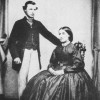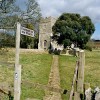Saturday the 9th of August 1856 saw Dorchester enveloped in penetrating drizzle. This miserable weather did nothing to dissuade the people of the town from being on the streets early, joining many from towns and villages the length and breadth of the county who where already assembling to witness the awful event to take place early that morning. The local newspaper estimated four thousand were out in the town.
Elizabeth Martha Clarke was in Dorchester. She had snatched only two hours sleep that night and declined breakfast deciding instead to make do with a cup of tea, for in a little over an hour she too had to keep an appointment she could not break. Those with her had noticed a quiet determination to see the business through with dignity. However, it is likely her mind was elsewhere probably recalling other times and wondering at the events that had brought her to Dorchester.
She had spent her childhood and most of her early adult years in an area known as Marshwood Vale, a quiet rural part of West Dorset where her father worked as a farm labourer and occasional dairyman and where even today it is narrow winding lanes that pass for roads. Her mother and father John and Martha Clark were married at Burstock on the 18th of February 1800; her mother’s maiden name was Hussey. She was one of eleven children and soon became known simply as Martha.
The 1830’s were the best years of her life. Probably through her father’s work she met Barnard Bearns a widower and a farmer of twice her years; they married on the 27th of December 1831. He came from the village of Askerswell and farmed land in the Powerstock area where he rented a prominent house ‘Meadways’ by the Maggerton River. Now no longer a farm labourer’s daughter, she was a farmer’s wife and content with her lot.
Barnard was for a while an Overseer to the Poor and well respected in the community. They were happy with each other despite the difference in their ages. Their two sons both died in 1835, William was born in 1832 and Thomas in 1834. On the 4th of May 1840 the couple witnessed the marriage of Martha’s sister Ann to John Record at Whitechurch Canonicorum.
These were difficult times for anyone earning their living from the land. Records show that late in the decade Barnard had financial difficulties. He ceased to be an Overseer to the poor and had to surrender his holdings at Powerstock.
Her husband died leaving her the sum of £50. She found work as the housekeeper to two farming brothers John and Robert Symes who held Blackmanston Farm in the Purbeck hills, quite a distance from the Marshwood Vale. It is likely she knew them previously. Both brothers were born near Powerstock; John in1805 and Robert in 1811 and the brothers habitually returned to the Marshwood Vale to hire their labour. Martha was housekeeper to the Symes brothers for 14 years and John Symes described her as “a most kind and inoffensive woman.”
Also from the Marshwood Vale area was Robert Brown who was dairyman on the Symes’ farm and his son John was employed there as a shepherd. A relationship grew between Martha and John Brown. Despite the fact that she was twice his age the couple married at Wareham on the 24th of January 1852. Soon after their marriage they returned to the Marshwood Vale and the remote hamlet of Birdsmoorgate.
They lived in a house with a small shop from which Martha sold sweets and groceries. Her young husband acquired a horse and cart and set up in business as a Carter. John’s cousin lived in the hamlet along with just a dozen or so other souls including Mary Davis a young woman well known to Martha, who had the other shop in the village. But it wasn’t trade that connected the two women as rather a matter of the heart.
Perhaps it was inevitable in a such a small community that an attraction would blossom between John a young man married to a women twice his age, and Mary a young woman married to a man almost old enough to be her grandfather.
There is no doubt Martha was jealous of the attraction Mary held for her husband. John would come home late, often drunk, offering vague excuses about where he had been. Martha knew full well that he had been with Mary; she had spied on them often enough to be in no doubt.
John arrived home at 2 o’clock in the morning of Sunday July 6th – he was drunk and vomiting. The couple argued about his supper and where he had been to such a late hour. As was often the case John was being physically and verbally abusive towards his wife when something within her snapped. She retaliated landing several blows to his head. A moment later and John Brown lay lifeless on the floor.
Thirty-four days had passed since Martha killed John Brown. In that short space of time there had been an inquest, Martha had been arrested, charged, tried and sentenced. The infamous Jeffreys who held court some two hundred years earlier was not alone in dispensing quick and rough justice at Dorchester.
Early on the morning of the 9th of August 1856 Mary Davis set off from Birdsmoorgate to see Martha Brown but the people of the village of Broadwindsor recognised her and insisted she turned back. There was little sympathy for Mary Davis because people knew that Brown would have been alive that day had she not encouraged his attentions.
Back in Dorchester that same morning Martha had decided to wear a black figure-hugging gown, which showed off her shapely figure. Mr Clementson and the Rev. Henry Moule were with her and gently reminded her it was time to leave: she decided, despite the drizzle, to walk rather than ride in the van.
She climbed the first flight of steps and at the top was met by William Calcraft – the public executioner. He bound her hands and she ascended the second flight of steps from where she could see the sea of faces surrounding the scaffold. She turned to Mr. Moule and thanked him for his kindness. Mr Clemetson had been overcome with emotion and sadness that his efforts to secure a reprieve had come to nought. He was unable to come to the top of the scaffold with her.
Calcraft placed her on the drop, put a cap over her head and adjusted the rope. The bolt was withdrawn and Elizabeth Martha Clarke left this world for a better place where we must all hope she was met with forgiveness and a more sympathetic justice.
Her lifeless body hung for the hour dictated by law, viewed by the thousands who had attended this awful event, most of them drawn there by a morbid curiosity. Amongst the crowd was a young man destined for literary greatness: the sight he witnessed that morning stayed with him for the rest of his life. Later the memory of that day was used to dramatic effect in one of his most powerful and popular novels, which is probably why the memory of this most kind and inoffensive woman lives on.



